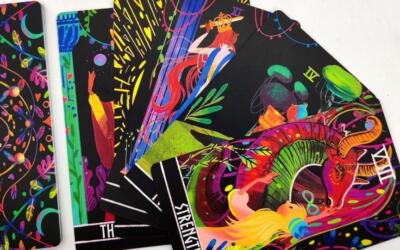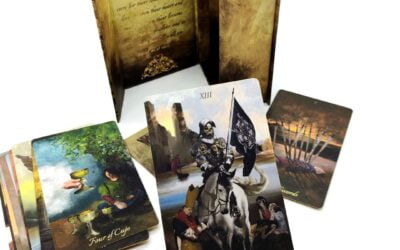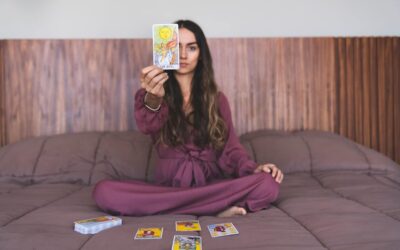In the last few months I’ve gifted two of my friends their first tarot decks and they asked “How do I start learning Tarot?”. Because they’re both long-distance friends, when it came to teaching the basics I got… busy. What I should have done, I thought, is send them a few links to start with, rather than leave them at the mercy of their own research, because they too can get too busy to start!
“Can you teach yourself to read tarot cards?”. The answer is “Yes!”.
And so, this blog post is a sort of Tarot 101 that’s long overdue for La Muci’s website! It’s a single page you can send to a complete tarot beginner, full of links for further reading! With no further ado, let’s dive straight into a series of basic questions and vocabulary that many advanced blog posts take for granted. We are starting with the most basic question, “What are tarot cards?”
What Are Tarot Cards? History of Tarot
Tarot cards have a long history dating back to ancient Egypt, but their most recognizable early incarnations are as Italian playing cards in the 15th century. In fact, the cards we use to play poker have the same roots as Tarot! It was around the 18th century when their use for divination purposes began. The most popular designs, Rider-Waite-Smith and Thoth, which most tarot decks are based on today, were commercialised in the early 20th century by members of the Order of the Golden Dawn, a secret society that studied the occult. If you are getting started with tarot as a beginner, you can also read:
- Tarot: 2,000 Years of Wisdom
- What is a Rider-Waite tarot deck and where does it come from?
- Thoth Tarot Deck vs. Rider Waite Smith Tarot Deck.
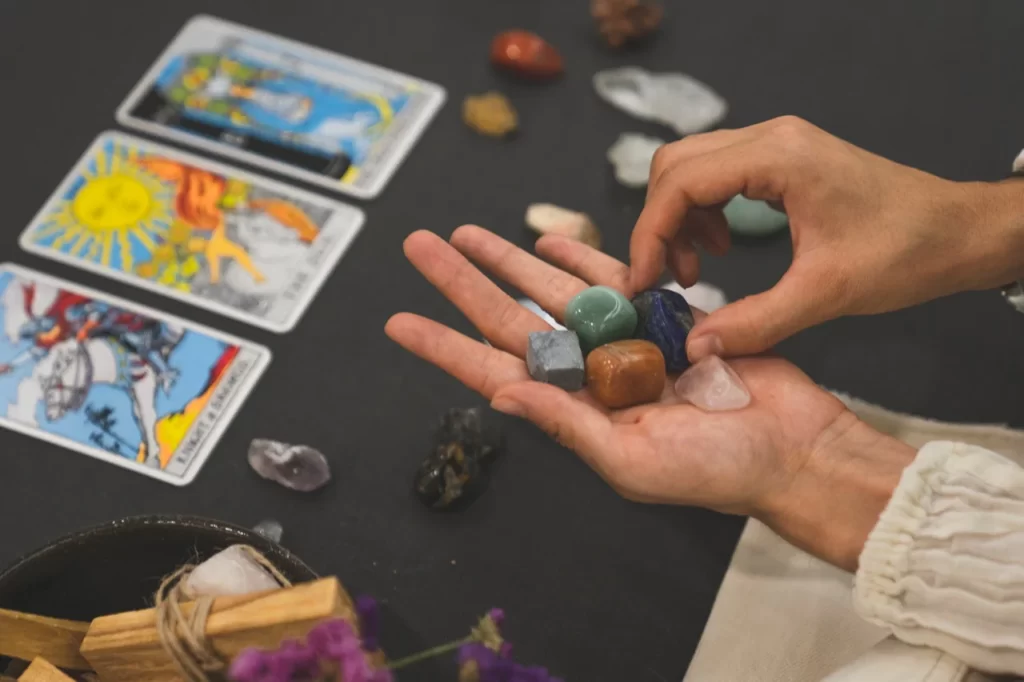
What does divination mean?
The are too many kinds of divination tools in our collection. But you can ask what does divination mean? When we ‘divinate’, we are seeking insight, wisdom and advice from a source beyond us. Your source is up to be, be it spirit, deities, your higher self, a guardian angel, a passed-away relative, your subconscious and more!
As a divination tool, tarot cards are merely the language of communication between you and your source. When divination, we use our intuition to interpret what the source might be trying to tell us using the visual and symbolic meanings of the cards during a tarot reading.
Learn more about divination tools:
What is a tarot reading?
A ‘reading’ is what we call a tarot session or séance. Tarot reading is when you sit down, ground yourself, begin asking questions from your source, shuffle and draw your cards and, finally, begin interpreting or ‘reading’ the spread for your answers. Because tarot is a language, we say we’re ‘reading’ the answers.
Read further:
What is a tarot spread?
A ‘spread’ is what we call the layout of your cards. Some people draw their cards freely without a layout, while many prefer to designate each card they draw a specific question. It’s like the grammar of tarot.
Spreads help tarot beginners interpret their answers more specifically. For example, you might ask, ‘what is the source of my problem?’, and draw a single card to represent that specific answer. Then you might ask, ‘what’s a suitable solution?’, and draw the next card. If you are not a tarot beginner, any tarot spreads are designed in advance, which you can find online created by others. There are also popularised tarot spreads that most tarot beginners start with.
Read further:

What does grounding mean?
In simple terms, grounding means you are focused on what you’re about to do, and have shielded yourself from any prior energies. It’s like you’ve put up a protective barrier around yourself, or have entered a germ-free ‘clean room’ in a hospital. This way, you ensure that your own thoughts and worries or distractions don’t interfere with your tarot reading.
It also is a time to specify where your guidance is coming from, so you don’t divinate with a random source. Once your tarot reading is over, you ‘release’ yourself and return to the ordinary, surrounding, daily energies around you.
There are various ways to ground, and you think of your own opening and closing rituals, but it can also be as simple as sitting quietly, clearing your thoughts, formulating your questions, then saying ‘I am open to receive guidance from…’, and when you’re closing, saying ‘I thank and release this energy, and now I am closed’. You can also read this article that i wrote for tarot beginners:
Read further:
Can tarot cards predict the future? What do I need to read tarot cards?
When you start tarot reading, as a beginner, you might ask this question. But, the answer is “No”.
Tarot cards can suggest a likeliest outcome based on the current situation, but things beyond our power are changing all the time. Which is why asking about a volatile, ever-changing future is unproductive. You have free will to make your own decisions. For beginners in tarot, we suggest more productive thing to ask is ‘how can I make x come true?’ or ‘what can I do to increase my chances of x?’ Now, you are using the present for self-development and shaping your plans.
So then, what are tarot cards used for?
In a tarot reading, tarot cards are used for problem-solving, analysis, self-care, making plans, understanding the past and present, and the like. The language of tarot cards can visualise feelings and subconscious wishes that we cannot describe, organise our thoughts, help us learn a lesson or keep in touch with ourselves. Tarot reading can help us gain confidence and a sense of a plan when we feel confused or can’t come up with actionable ideas.
Modern practitioners commonly do career and education tarot readings, decision makings including the heart and mind, healing and psychology, working out what we could do in our relationships, and what we might want to focus on or prioritise at any given time.
Read further:
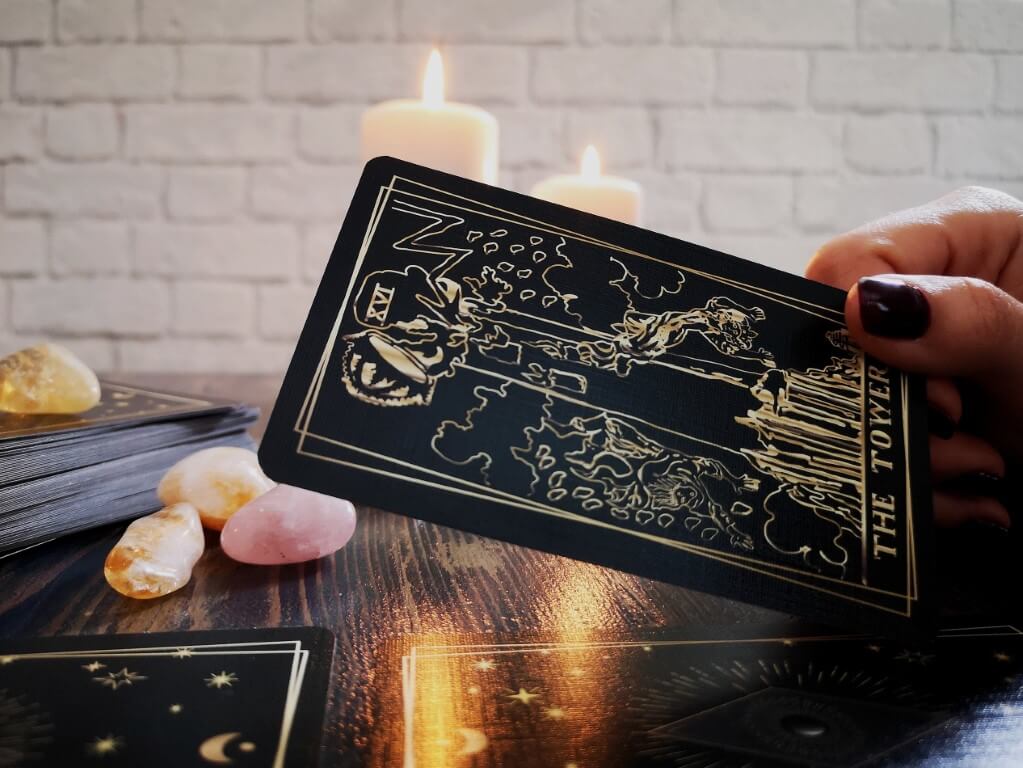
How many tarot cards are in a tarot deck? Must I memorise them all?
There are 78 cards in a tarot deck, and no, you don’t have to study every card as if for an exam in order to start reading. But, what do the different types of tarot cards mean?
Every tarot card can represent countless possibilities depending on its position, combinations, the question and even the design! However, most decks come with a guidebook, and there are plenty of online sources to help you interpret as you go.
Divination is an intuitive process. You go with your gut feeling, and can take only whatever resonates from a tarot guidebook. Once you understand the very short basics of numerology; the 4 elements, and the simple fool’s journey through the 22 major arcana cards in tarot, that’s all you need to begin reading intuitively without a tarot guidebook. Mind you, there’s nothing wrong with using a tarot guidebook even for advanced tarot readers!
Read further:
How many cards are in a tarot spread? Can I do a one card reading?
How many cards are used in a tarot reading? There is no maximum number of cards per se! If you feel like your tarot reading requires you to keep drawing up to 20 cards, then by all means. If you’re satisfied with one, that’s also right. It depends on how you design a tarot spread. In fact, you can divide your tarot reading into sections, where you shuffle the cards again for the next question. You can even use other divination cards, like Lenormands and Oracle cards, or even more tarot decks for a different perspective. Many beginners start by drawing one card a day in the morning and then journal about it in the evening.
Read further:
- How to do a YES NO Tarot reading for quick answers?
- What are the differences between Tarot Cards and Oracle Cards?
- Using Tarot and Lenormand together + spreads!

Do I need to be psychic to read tarot?
When you are a beginner in tarot, you might wonder “How do I prepare the deck?”. However, tarot is an experience that can be both spiritual as well as entirely analytical! It doesn’t require you to be any different from everybody else. It is, after all, a language, an art form, and a system. These are things anyone can learn! You just have to keep in mind that your divination tools and style and interpretation methods are going to be different from others. On the other hand, you might take inspiration from someone’s style on social media or a Youtuber. Everyone can find their own connection with tarot and practice tarot reading uniquely.
Read further:
- Are tarot cards witchcraft?
- How do I explain Tarot cards to family, friends and colleagues?
- Can anyone learn to read tarot and successfully give an accurate Tarot reading?
Last but not least. How do I choose my first deck?
At this point, you might ask “How do I know which tarot deck is right for me?”. If you came to this page to merely consider tarot and haven’t gone about getting your first deck yet, then I’ve have a blogpost all about that in the links below! But in short, going with a ‘gut feeling’ or ‘love at first sight’ is generally a good way to go about buying your first tarot deck. If you think you’d enjoy studying every little symbolism of a card, go for a highly illustrated one. If you think you’re more straight-to-the-point or impatient, you might want to go with a minimalist design. Any deck could be your first deck. After all, it is said that a deck chooses you, too. I mean, you should pick up which tarot deck is best for you.
Post Scriptum
Thank you for reading this complete guide about tarot for beginners. It’s been really fun and enlightening to put this post together, as it incorporates more than half of La Muci’s informative blog posts into one! I feel like this is truly the kind of post I myself could and will send to anyone I gift a deck or who show interest in my practices. Feel free to leave a comment to any more questions below, because no doubt this post will get updated with more content to come over time. Happy reading!

